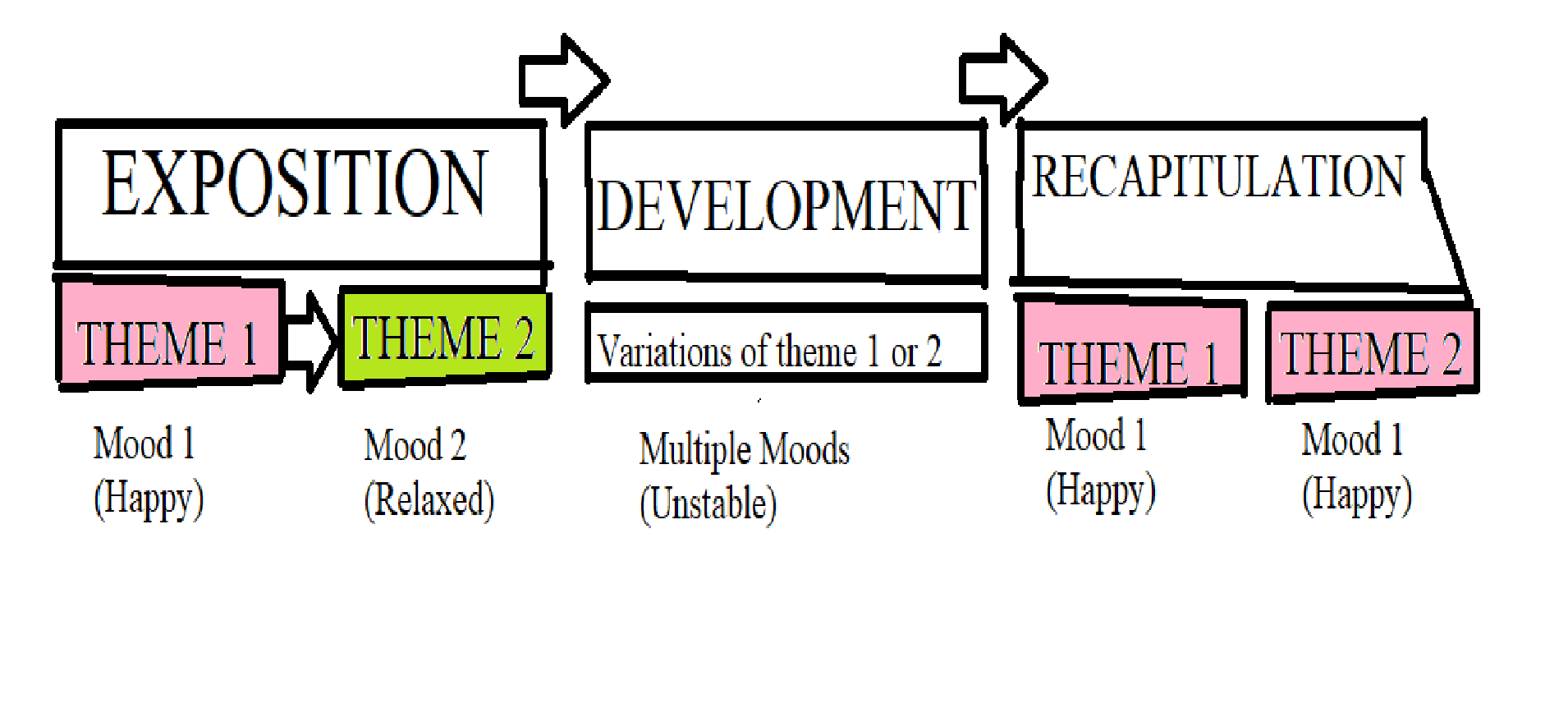Three Definitions of “Sonata Form”
Introduction
The objective of this document is to define “sonata form” for those unfamiliar with the term, using a parenthetical, sentence, and extended definition. For the extended definition, I explain the etymology of “sonata”, analyze its parts, provide a visual representation, and compare it to pop songs’ verse-chorus structure.
Reading Situation:
I am a music historian teaching an online classical music course for beginners, and it is near the start of the course. We are discussing Mozart and Beethoven, and I want to explain “sonata form” so my students can better understand those composers’ music.
Parenthetical Definition:
In many of their symphonies, Mozart and Beethoven use sonata form (music structure where a melody is played, modified, then repeated).
Sentence Definition:
Sonata form is way of organizing music commonly used by classical composers like Mozart or Beethoven. Sonata form has three distinct sections: the exposition, the development, and the recapitulation, and must appear in that order. Like a debate between two ideas, music in sonata form first states two opposing ideas/melodies (exposition), then expands upon each (development), and finally, restates them with some compromise (recapitulation).
Extended Definition:
- Etymology: “Sonata” is an Italian word, like many classical music terms, and means “sounded” (Burkholder, 2019). The “sounded” refers to an instrument being played, as sonatas are typically played by one or more instruments.
- Analysis of Parts: A piece in sonata form has three major sections: the exposition, the development, and the recapitulation.
- Exposition: This section introduces a melody which sets the mood of the entire piece. Music scholars often call this melody “Theme 1” or the “First Theme,” and it is a subsection of the exposition section. This subsection featuring Theme 1 can be as short as ten to thirty seconds, or as long as ten minutes, depending on the piece’s overall length. After Theme 1, the music moves to a subsection featuring Theme 2, a new melody that contrasts the previous theme in mood, rhythm, and or intensity, among other aspects. This Theme 2 subsection can be long or short, but usually matches the length of the Theme 1 subsection. Theme 2 can appear immediately after the Theme 1 subsection is complete, but in longer pieces, there is often a brief transition or bridge between the two themes to build tension. Once the Theme 2 subsection is complete, the music moves to the development section.
- Development: This section is the most open-ended in terms of what can occur, and rarely follows a formula (Sarnecki, 2010). However, the development section’s one consistent feature is it starts heavily modifying or varying the melodies of Theme 1 and/or 2, often breaking the melodies into smaller units. The purpose of the development section and varying the melodies is to explore the melodies’ creative potential, while creating variety and excitement as they are extended, shortened, made more complex, simplified, or combined into new forms. Like the other sections, the development section can be long or short. Lastly, to create further excitement, the development section frequently shifts to a darker and more unstable mood.
- Recapitulation: This section is literally a “recap” of the piece. The recapitulation repeats all the music from the exposition in the same order, the only difference being that the two themes are slightly altered to have a similar mood. This gives the music closure, as at least one difference between the themes is resolved.
- Visual

- Comparison: Sonata form is like some songs’ verse-chorus structure, but with crucial differences. A song with verse-chorus structure plays one melody, the verse, and then a new contrasting melody, the chorus (Form in pop/rock music, 2018). Like verse-chorus structure, sonata form in its exposition section plays two contrasting melodies: Theme 1 followed by Theme 2. However, while a verse-chorus song alternates the verse and chorus as much as desired, in sonata form, the exposition section typically repeats only once in its entirety before moving to the development section. On a larger scale, the exposition and recapitulation are like the chorus, while the development is like an extended verse or “breakdown” section. Like the chorus, the music in the exposition comes back mostly unchanged in the recapitulation. Meanwhile, like an extended verse or “breakdown”, the development section elaborates on the music’s story and builds up tension as we anticipate the return of the chorus/recapitulation.
Works Cited
Burkholder, J. Peter, et al. A History of Western Music. 10th ed., W.W. Norton and Company, 2019.
Form in pop/rock music – Overview –. (2018). Open Music Theory. Retrieved June 7, 2022, from http://openmusictheory.com/popRockForm.html
Sarnecki, Mark. Harmony: Intermediate. Frederick Harris Music, 2010.
Leave a Reply